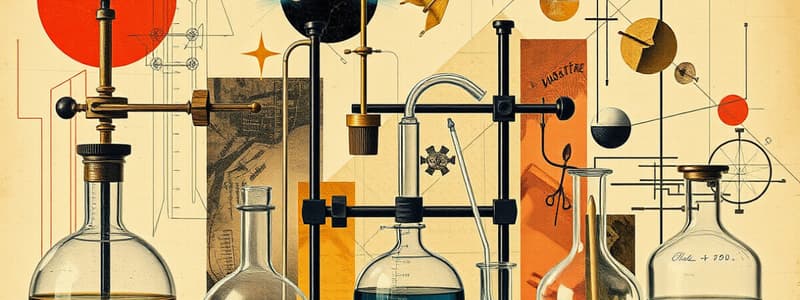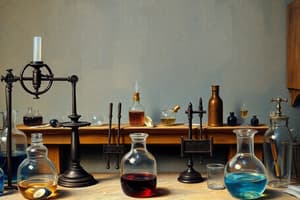Podcast
Questions and Answers
Which laboratory apparatus is specifically designed to accurately measure and prepare solutions of a specific volume?
Which laboratory apparatus is specifically designed to accurately measure and prepare solutions of a specific volume?
- Beaker
- Graduated Cylinder
- Volumetric Flask (correct)
- Erlenmeyer Flask
What is the primary use of a microscope in the laboratory?
What is the primary use of a microscope in the laboratory?
- To heat chemical reactions
- To measure liquid volumes
- To produce enlarged images of microscopic objects (correct)
- To mix solutions
Which type of flask is characterized by a flat bottom and a conical body, with applications in liquid handling?
Which type of flask is characterized by a flat bottom and a conical body, with applications in liquid handling?
- Florence Flask
- Erlenmeyer Flask (correct)
- Burette
- Volumetric Flask
For what purpose is a pipette primarily used in laboratory settings?
For what purpose is a pipette primarily used in laboratory settings?
Which piece of apparatus is best suited for holding multiple test tubes in an upright position?
Which piece of apparatus is best suited for holding multiple test tubes in an upright position?
What is the function of an evaporating dish in laboratory procedures?
What is the function of an evaporating dish in laboratory procedures?
Which laboratory apparatus is primarily used in quantitative chemical analysis to dispense variable amounts of solution?
Which laboratory apparatus is primarily used in quantitative chemical analysis to dispense variable amounts of solution?
Which item is commonly used as a cover for beakers to prevent dust from entering?
Which item is commonly used as a cover for beakers to prevent dust from entering?
What is the primary purpose of a crucible in a laboratory setting?
What is the primary purpose of a crucible in a laboratory setting?
Which piece of equipment is essential for measuring temperature accurately?
Which piece of equipment is essential for measuring temperature accurately?
What is the function of a glass stirring rod in a laboratory?
What is the function of a glass stirring rod in a laboratory?
Which laboratory equipment is used to channel liquids into small containers?
Which laboratory equipment is used to channel liquids into small containers?
What is the primary use of wire gauze in a laboratory?
What is the primary use of wire gauze in a laboratory?
Which piece of equipment is specifically designed to hold hot crucibles safely?
Which piece of equipment is specifically designed to hold hot crucibles safely?
What does a double burette holder facilitate in the laboratory?
What does a double burette holder facilitate in the laboratory?
When would you use beaker tongs in a laboratory setting?
When would you use beaker tongs in a laboratory setting?
What is the primary use of a scalpel?
What is the primary use of a scalpel?
Which of the following best describes the purpose of a Bunsen burner?
Which of the following best describes the purpose of a Bunsen burner?
What distinguishes an analytical balance from a triple beam balance?
What distinguishes an analytical balance from a triple beam balance?
What type of fuel does an alcohol lamp use?
What type of fuel does an alcohol lamp use?
For what purpose is rubber tubing primarily used in laboratory settings?
For what purpose is rubber tubing primarily used in laboratory settings?
What is the main function of a spot plate in a laboratory?
What is the main function of a spot plate in a laboratory?
What is the primary function of a hot plate in a laboratory?
What is the primary function of a hot plate in a laboratory?
Which laboratory instrument is specifically designed to measure the mass of various objects with high accuracy?
Which laboratory instrument is specifically designed to measure the mass of various objects with high accuracy?
What is the primary function of a centrifuge in a laboratory setting?
What is the primary function of a centrifuge in a laboratory setting?
Which laboratory apparatus is specifically designed to distill liquids with different boiling points?
Which laboratory apparatus is specifically designed to distill liquids with different boiling points?
What is one of the key uses of filter paper in the laboratory?
What is one of the key uses of filter paper in the laboratory?
What material is often used to seal containers in laboratory experiments?
What material is often used to seal containers in laboratory experiments?
What instrument is used to measure the acidity or alkalinity of a solution?
What instrument is used to measure the acidity or alkalinity of a solution?
Which laboratory tool would you use to crush or grind solid substances?
Which laboratory tool would you use to crush or grind solid substances?
Flashcards are hidden until you start studying
Study Notes
Common Laboratory Apparatus
-
Test Tube: Holds, mixes, or heats small quantities of solid or liquid chemicals for qualitative experiments.
-
Test Tube Rack: Supports multiple test tubes upright simultaneously.
-
Microscope: Produces enlarged images of microscopic objects for detailed observation.
-
Beaker: A multipurpose vessel for containing reactions, measuring liquids, heating, and collecting during titrations.
-
Graduated Cylinder: An elongated, cylindrical vessel marked with graduations for precise volume measurement and easy pouring.
-
Erlenmeyer Flask: Features a flat bottom, conical body, and cylindrical neck; versatile for various liquid handling applications.
-
Volumetric Flask: Flat bottom bulb with an elongated neck; used for accurate volume measurements and preparing specific solution concentrations.
-
Florence Flask: Recognized by its long neck and rounded bottom for use as both a reaction vessel and heating solution.
-
Burette: Measures and dispenses variable amounts of liquid or gas in quantitative chemical analysis.
-
Pipette: Transfers measurable volumes of liquid; made from glass or plastic.
-
Petri Dish: Cultures different types of cells, including bacteria and molds.
-
Watch Glass: Round glass used to evaporate liquids, weigh solids, or cover beakers to prevent contamination.
-
Evaporating Dish: A glazed porcelain vessel for heating and evaporating liquids.
-
Crucible: Cup-shaped equipment used for containing substances at high temperatures.
-
Thermometer: Glass tube instrument using mercury to measure temperature.
-
Stirring/Glass Rod: Glass tool for mixing or stirring chemicals and liquids.
-
Funnel: A conically shaped tool for channeling liquids or fine powders into small openings.
-
Wire Gauze: A heat-resistant surface that ensures even heat distribution for containers.
-
Forceps: Grasping instruments used for holding objects securely.
-
Crucible Tongs: Steel tools for safely lifting hot crucibles.
-
Beaker Tongs: Specialized tongs for handling hot beakers containing hazardous substances.
-
Test Tube Holder: Wire tool that securely holds test tubes using a U-shaped design.
-
Iron Stand: Equipment to support various laboratory apparatus such as burettes and flasks.
-
Tripod: Three-legged stand that supports containers during heating.
-
Iron Ring: Provides support for equipment above work surfaces in labs.
-
Double Burette Holder: A clamp for securely holding two burettes during titrations.
-
Spatula: Used to transport and distribute dry chemical compounds.
-
Scalpel: Precision cutting tool ideal for detailed work and accessible in tight spaces.
-
Alcohol Lamp: Heating device that uses ethyl alcohol for sterilization and combustion.
-
Bunsen Burner: Utilized for heating, combustion, and sterilization processes.
-
Hot Plate: Provides uniform heat for solutions and materials in experiments.
-
Triple Beam Balance: An instrument with three beams for measuring the mass of various objects accurately.
-
Aspirator: Used to remove liquids from containers, such as water and chemicals.
-
Spot Plate: A plate with small wells for isolating samples in laboratory tests.
-
Rubber Tubing: Facilitates the flow of fluids and gases, often connected to condensers during distillation.
-
Gun Lighter: Commonly used to ignite gas and air mixtures.
-
Base/Acid Burette: Delivers measured volumes of acid or base solutions for titration experiments.
-
Analytical Balance: Measures mass precisely in quantitative analysis of solids and liquids.
-
Condenser: Laboratory apparatus that condenses vapors into liquids through cooling.
-
Distilling Flask: Utilized for separating mixtures based on different boiling points.
-
Mortar and Pestle: Contains materials for grinding or crushing purposes.
-
Filter Paper: Acts as a semi-permeable barrier to separate components from air or liquid.
-
Cork: Used to seal test tubes and flasks; impermeable and non-toxic.
-
Cork Borer: Metal tool for cutting holes in cork or rubber stoppers to insert tubing.
-
pH Meter: Measures the acidity or alkalinity of a solution accurately.
-
Centrifuge: Separates fluids based on density through high-speed rotation of samples.
Studying That Suits You
Use AI to generate personalized quizzes and flashcards to suit your learning preferences.




